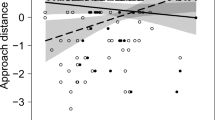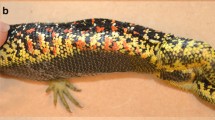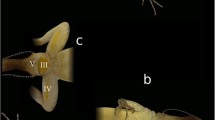Abstract
Despite the functional significance of melanin-based plumage coloration in social and sexual signaling, the mechanisms controlling its information content are poorly understood. The T-regulation hypothesis proposes that melanin ornaments signal competitive abilities via the effects of testosterone (T) mediating both melanization and sexual/aggressive behaviors. Using the phylogenetic comparative approach, we tested whether frontal black melanization is associated with elevated T around the time of breeding plumage development across all bird species with available T-data. We found a context-dependent relationship between melanization and T, varying with the type of ornamentation (patchy or full-black) and with the presumed taxonomic distribution of the hormonal control of plumage dichromatism. Within two taxa in which male plumage development is assumed androgen-dependent (Charadriiformes, Corvida), evolutionary increases in male melanization, and melanin dichromatism correlated with increases in T in most analyses but not within the basal lineage (ratites, Galloanseriformes) with androgen-independent male plumage. Among Passeroidea with presumably genetically or luteinizing-hormone-based male plumage, melanization and its dichromatism correlated with T only in species with <100% frontal melanization. These results were robust as we controlled for several confounding variables such as mating and parental behaviors. This study is the first to test and support the T-regulation hypothesis interspecifically, suggesting that among-species differences in melanization may have evolved in response to differences in circulating T in certain avian taxa. Our results imply that the extent of black ornamentation may serve as an honest indicator of male competitiveness in those species that evolved an appropriate hormonal basis (T dependence) for color production.

Similar content being viewed by others
References
Andersson M (1994) Sexual selection. Princeton University Press, Princeton
Barker FK, Cibois A, Schikler P, Feinstein J, Cracraft J (2004) Phylogeny and diversification of the largest avian radiation. Proc Natl Acad Sci U S A 101:11040–11045
Bennett PM, Owens IPF (2002) Evolutionary ecology of birds: life histories, mating systems and extinction. Oxford University Press, Oxford
Bennett ATD, Cuthill IC, Partridge JC, Lunau K (1997) Ultraviolet plumage colors predict mate preferences in starlings. Proc Natl Acad Sci U S A 94:8618–8621
Bókony V, Liker A (2005) Melanin-based black plumage coloration is related to reproductive investment in cardueline finches. Condor 107:775–787
Bókony V, Liker A, Székely T, Kis J (2003) Melanin-based plumage coloration and flight displays in plovers and allies. Proc R Soc Lond B 270:2491–2497
Brawner WR, Hill GE, Sundermann CA (2000) Effects of coccidial and mycoplasmal infections on carotenoid-based plumage pigmentation in male House Finches. Auk 117:952–963
Buchanan KL, Evans MR, Goldsmith AR, Bryan DM, Rowe LV (2001) Testosterone influences basal metabolic rate in male house sparrows: a new cost of dominance signalling? Proc R Soc Lond B 268:1337–1344
Burtt EH, Ichida JM (2004) Gloger’s rule, feather-degrading bacteria, and color variation among song sparrows. Condor 106:681–686
Carefoot WC (2002) Hen-feathering mutation HF*H may act as a eumelanising factor and modify the expression of autosomal barring. Br Poult Sci 43:391–394
Cohen J (1988) Statistical power analysis for the behavioural sciences. Erlbaum, Hillsdale
Doucet SM, Shawkey MD, Hill GE, Montgomerie R (2006) Iridescent plumage in satin bowerbirds: structure, mechanisms and nanostructural predictors of individual variation in colour. J Exp Biol 209:380–390
Edwards PJ (1982) Plumage variation, territoriality and breeding displays of the golden plover Pluvialis apricaria in Southwest Scotland. Ibis 124:88–95
Evans MR, Goldsmith AR, Norris SRA (2000) The effects of testosterone on antibody production and plumage coloration in male house sparrows (Passer domesticus). Behav Ecol Sociobiol 47:156–163
Fargallo JA, Laaksonen T, Korpimäki E, Wakamatsu K (2007a) A melanin-based trait reflects environmental growth conditions of nestling male Eurasian kestrels. Evol Ecol 21:157–171
Fargallo JA, Martínez-Padilla J, Toledano-Díaz A, Santiago-Moreno J, Dávila JA (2007b) Sex and testosterone effects on growth, immunity and melanin coloration of nestling Eurasian kestrels. J Anim Ecol 76:201–209
Fitze PS, Richner H (2002) Differential effects of a parasite on ornamental structures based on melanins and carotenoids. Behav Ecol 13:401–407
Freckleton RP, Harvey PH, Pagel M (2002) Phylogenetic analysis and comparative data: a test and review of evidence. Am Nat 160:712–726
Garamszegi LZ (2006) Comparing effect sizes across variables: generalization without the need for Bonferroni correction. Behav Ecol 17:682–687
Garamszegi LZ, Eens M, Hurtrez-Boussès S, Møller AP (2005) Testosterone, testes size and mating success in birds: a comparative study. Horm Behav 47:389–409
González G, Sorci G, Smith LC, de Lope F (2001) Testosterone and sexual signalling in male House Sparrows (Passer domesticus). Behav Ecol Sociobiol 50:557–562
Goymann W, Moore IT, Scheuerlein A, Hirschenhauser K, Grafen A, Wingfield JC (2004) Testosterone in tropical birds: effects of environmental and social factors. Am Nat 164:327–334
Grafen A, Hails R (2002) Modern statistics for the life sciences. Oxford University Press, Oxford
Griffith SC, Owens IPF, Burke T (1999) Environmental determination of a sexually selected trait. Nature 400:358–360
Griffith SC, Parker TH, Olson VA (2006) Melanin- versus carotenoid-based sexual signals: is the difference really so black and red? Anim Behav 71:749–763
Haase E, Schmedemann R (1992) Dose-dependent effect of testosterone on the induction of eclipse coloration in castrated wild mallard drakes (Anas platyrhynchos L.). Can J Zool 70:428–431
Haase E, Ito S, Wakamatsu K (1995) Influences of sex, castration, and androgens on the eumelanin and pheomelanin contents of different feathers in wild Mallards. Pigment Cell Res 8:164–170
Hegner RE, Wingfield JC (1987) Effects of experimental manipulation of testosterone levels on parental investment and breeding success in male house sparrows. Auk 104:462–469
Hill GE (1990) Female house finches prefer colourful males: sexual selection for a condition-dependent trait. Anim Behav 40:563–572
Hill GE (2006) Female mate choice for ornamental coloration. In: Hill GE, McGraw KJ (eds) Bird coloration II. Function and evolution. Harvard University Press, Cambridge, pp 137–200
Hill GE, Montgomerie R (1994) Plumage colour signals nutritional condition in the house finch. Proc R Soc Lond B 258:47–52
Hill GE, Brawner WR (1998) Melanin-based plumage coloration in the House Finch is unaffected by coccidial infection. Proc R Soc Lond B 265:1105–1109
Hill GE, McGraw KJ (2003) Melanin, nutrition, and the lion’s mane. Science (Lett) 299:660
Hirschenhauser K, Winkler H, Oliveira RF (2003) Comparative analysis of male androgen responsiveness to social environment in birds: the effects of mating system and paternal incubation. Horm Behav 43:508–519
Jawor JM, Breitwisch R (2003) Melanin ornaments, honesty, and sexual selection. Auk 120:249–265
Ketterson ED, Nolan V Jr, Sandell M (2005) Testosterone in females: mediator of adaptive traits, constraint on sexual dimorphism, or both? Am Nat 166:S85–98
Kimball RT (2006) Hormonal control of coloration. In: Hill GE, McGraw KJ (eds) Bird coloration I. Mechanisms and measurements. Harvard University Press, Cambridge, pp 137–200
Kimball RT, Ligon JD (1999) Evolution of avian plumage dichromatism from a proximate perspective. Am Nat 154:182–193
Lendvai AZ, Kis J, Székely T, Cuthill IC (2004) An investigation of mate choice based on manipulation of multiple ornaments in Kentish Plovers. Anim Behav 67:703–709
Liker A, Székely T (2005) Mortality costs of sexual selection and parental care in natural populations of birds. Evolution 59:890–897
Mahler B, Araujo LS, Tubaro PL (2003) Dietary and sexual correlates of carotenoid pigment expression in dove plumage. Condor 105:258–267
Martins EP, Hansen TF (1997) Phylogenies and the comparative method: a general approach to incorporating phylogenetic information into the analysis of interspecific data. Am Nat 149:646–667
McGraw KJ (2003) Melanins, metals, and mate quality. Oikos 102:402–406
McGraw KJ (2006) Mechanics of melanin-based coloration. In: Hill GE, McGraw KJ (eds) Bird coloration I. Mechanisms and measurements. Harvard University Press, Cambridge, pp 243–294
McGraw KJ, Hill GE (2000) Differential effects of endoparasitism on the expression of carotenoid- and melanin-based ornamental coloration. Proc R Soc Lond B 267:1525–1531
McGraw KJ, Vonnegut EA, Dale J, Hauber ME (2002) Different plumage colors reveal different information: how nutritional stress affects the expression of melanin- and structurally based ornamental coloration. J Exp Biol 205:3747–3755
McGraw KJ, Dale J, Mackillop EA (2003) Social environment during molt and the expression of melanin-based plumage pigmentation in male house sparrows (Passer domesticus). Behav Ecol Sociobiol 53:116–122
McGraw KJ, Wakamatsu K, Ito S, Nolan PM, Jouventin P, Dobson FS, Austic RE, Safran RJ, Siefferman LM, Hill GE, Parker RS (2004) You can’t judge a pigment by its color: carotenoid and melanin content of yellow and brown feathers in swallows, bluebirds, penguins, and domestic chickens. Condor 106:390–395
Møller AP, Jennions MD (2002) How much variance can be explained by ecologists and evolutionary biologists? Oecologia 132:492–500
Møller AP, Garamszegi LZ, Gil D, Hurtrez-Boussès S, Eens M (2005) Correlated evolution of male and female testosterone profiles in birds and its consequences. Behav Ecol Sociobiol 58:534–544
Nakagawa S (2004) A farewell to Bonferroni: the problems of low statistical power and publication bias. Behav Ecol 15:1044–1045
Olson VA, Owens IPF (2005) Interspecific variation in the use of carotenoid-based coloration in birds: diet, life history and phylogeny. J Evol Biol 18:1534–1546
Owens IPF, Hartley IR (1998) Sexual dimorphism in birds: why are there so many different forms of dimorphism? Proc R Soc Lond B 265:397–407
Owens M (1997) Inferring evolutionary processes from phylogenies. Zool Scripta 26:331–348
Pagel M (1999) Inferring the historical patterns of biological evolution. Nature 401:877–884
Peters A, Astheimer LB, Boland CRJ, Cockburn A (2000) Testosterone is involved in acquisition and maintenance of sexually selected male plumage in superb fairy-wrens, Malurus cyaneus. Behav Ecol Sociobiol 47:438–445
Poston JP, Hasselquist D, Stewart IRK, Westneat DF (2005) Dietary amino acids influence plumage traits and immune responses of male house sparrows, Passer domesticus, but not as expected. Anim Behav 70:1171–1181
Roberts ML, Buchanan KL, Evans MR (2004) Testing the immunocompetence handicap hypothesis: a review of the evidence. Anim Behav 68:227–239
Roulin A, Dijkstra C (2003) Genetic and environmental components of variation in eumelanin and phaeomelanin sex-traits in the barn owl. Heredity 90:359–364
Roulin A, Riols C, Dijkstra C, Ducrest A-L (2001) Female plumage spottiness signals parasite resistance in the barn owl (Tyto alba). Behav Ecol 12:103–110
Roulin A, Müller W, Sasvári L, Dijkstra C, Ducrest AL, Riols C, Wink M, Lubjuhn T (2004) Extra-pair paternity, testes size and testosterone level in relation to colour polymorphism in the barn owl Tyto alba. J Avian Biol 35:492–500
Senar JC (2006) Color displays as intrasexual signals of aggression and dominance. In: Hill GE, McGraw KJ (eds) Bird coloration II. Function and evolution. Harvard University Press, Cambridge, pp 87–136
Sibley CG, Ahlquist JE (1990) Phylogeny and classification of birds: a study in molecular evolution. Yale University Press, New Haven
Wingfield JC, Ball GF, Duffy AM Jr, Hegner RE, Ramenofsky M (1987) Testosterone and aggression in birds. Am Sci 75:602–608
Wingfield JC, Hegner RE, Dufty AM Jr, Ball GF (1990) The ‘challenge hypothesis’: theoretical implications for patterns of testosterone secretion, mating systems and breeding strategies. Am Nat 136:829–846
Wingfield JC, Lynn SE, Soma KK (2001) Avoiding the ‘costs’ of testosterone: ecological bases of hormone-behavior interactions. Brain Behav Ecol 57:239–251
Acknowledgments
We thank four anonymous referees for valuable comments on the manuscript. VB and AL were supported by the Hungarian Scientific Research Fund (OTKA, T047256), VB by an Eötvös scholarship from the Hungarian Scholarship Board (MÖB), and AL by a Bolyai János Research Fellowship. LZG received a post-doc grant from FWO, Vlaanderen (Belgium). KH was supported by a post-doctoral grant from the Fundação para a Ciência e a Tecnologia (PRAXIS XI/BPD/20142/99), and a research grant to R. F. Oliveira, ISPA, Lisbon, Portugal (FCT; PRAXIS XXI/P/BIA/10251/98).
Author information
Authors and Affiliations
Corresponding author
Additional information
Communicated by: K. McGraw
Electronic supplementary material
Below is the link to the electronic supplementary material.
S1
Reliability of species-specific T measures used in the study (DOC 31 kb)
S2
Data on melanization, T levels, and confounding variables used in the analyses (DOC 397 kb)
S3
Topology and references of the composite phylogenies used in the analyses (DOC 431 KB)
S4
Full multivariate phylogenetic GLS models of male melanization and melanin dichromatism in relation to T levels and sexual and paternal behaviors (DOC 70 kb)
Rights and permissions
About this article
Cite this article
Bókony, V., Garamszegi, L.Z., Hirschenhauser, K. et al. Testosterone and melanin-based black plumage coloration: a comparative study. Behav Ecol Sociobiol 62, 1229–1238 (2008). https://doi.org/10.1007/s00265-008-0551-2
Received:
Revised:
Accepted:
Published:
Issue Date:
DOI: https://doi.org/10.1007/s00265-008-0551-2




